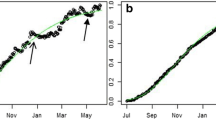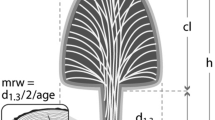Abstract
We derive and analyze a model that relates the growth rate of cross-sectional area (‘csa’) at any height on the central stem of a tree to crown-length dynamics. The derivation is based, in part, on assumptions that (a) active csa on the central stem relates allometrically to the length of crown above the cross section, and (b) inactive csa is proportional to active csa within the crown. We also assume that the deactivation rate of csa beneath the crown is determined, in part, by the rate of crown rise. Integration of the growth-rate model under an additional assumption—that total crown length is constant after stand closure—provides a simple model of annual or periodic growth of total csa that can be fit to standard growth data. Three implications of the assumptions and integration are notable: (1) total csa within the crown scales allometrically with stem length above the cross section; (2) for a special case, total csa beneath the crown scales with stem length above the cross section; more generally, csa scales with a linear combination of the stem and crown lengths; and (3) the stem beneath the crown forms to approximate a frustum of a quadratic paraboloid. Basal area data from a loblolly pine (Pinus taeda L.) spacing trial show good agreement with (1) and (2), and with an empirical model developed from the special case of (2). Data from the plots of a Norway spruce (Picea abies (L.) Karst.) thinning trial, where crown length remained approximately constant, show good agreement with (2) and the empirical model. Prediction (3) is demonstrated by simulation.







Similar content being viewed by others
References
Amateis RL, Burkhart HE, Zedaker SM (1988) Experimental design and early analyses for a set of loblolly pine spacing trials. In: Ek AR, Shifley SR, Burk TE (eds) Forest growth modeling and prediction, forest service, north central experiment station, St Paul, Minnesota, General Technical Report NC-120, pp 1058–1065
Assmann E (1970) The principles of forest yield study. Pergamon Press, Oxford
Beekhuis J (1965) Crown depth of radiata pine in relation to stand density and height. NZ J For 10:43–61
Cajander AK (1949) Forest types and their significance. Acta For Fenn 56:1–71
Chiba Y, Fujimori T, Kiyono Y (1988) Another interpretation of the profile diagram and its availability with consideration of the growth process of forest trees. J Jpn For Soc 70:245–254
Curtis RO, Reukema DL (1970) Crown development and site estimates in a Douglas-fir plantation spacing test. For Sci 16:287–300
Fish H, Lieffers VJ, Silins U, Hall RJ (2006) Crown shyness in lodgepole pine stands of varying stand height, density, and site index in the upper foothills of Alberta. Can J For Res 36:2104–2111
Gray HR (1956) The form and taper of forest-tree stems. Institute Paper 32, Imperial Forestry Institute, University of Oxford, Oxford
Lin CH, Morse PM (1975) A compact design for spacing experiments. Biometrics 31:661–671
Longetaud F, Mothe F, Leban J-M, Mäkelä A (2006) Picea abies sapwood width: variation within and between trees. Scand J For Res 21:41–53
MacFarlane DW, Green EJ, Burkhart HE (2000) Population density influences assessment and application of site index. Can J For Res 30:1472–1475
Mäkelä A (1997) A carbon balance model of growth and self-pruning in trees based on structural relationships. For Sci 43:7–24
Mäkelä A (2002) Derivation of stem taper from the pipe theory in a carbon balance framework. Tree Physiol 22:891–905
Mäkelä A, Sievänen R (1992) Height-growth strategies in open-grown trees. J Theor Biol 159:443–467
Mäkelä A, Valentine HT (2006) Crown ratio influences allometric scaling in trees. Ecology 87(12):2967–2972
Mäkinen H, Isomäki A (2004a) Thinning intensity and growth of Norway spruce stands in Finland. Forestry 77:349–364
Mäkinen H, Isomäki A (2004b) Thinning intensity and long-term changes in increment and stem form of Norway spruce trees. For Ecol Manag 201:295–309
Mitchell KJ (1975) Dynamics and simulated yield of Douglas-fir. For Sci Monogr 17:1–37
Osawa A, Ishizuka M, Kanazawa Y (1991) A profile theory of tree growth. For Ecol Manag 41:33–63
\({\sf R}\) Development Core Team (2010) \({\sf R}\): a language and environment for statistical computing. \({\sf R}\) foundation for statistical computing. Vienna, Austria
Shinozaki K, Yoda K, Hozumi K, Kira T (1964) A quantitative analysis of plant form—the pipe model theory. II. Further evidence of the theory and its application in forest ecology. Jpn J Ecol 14:133–139
Soetaert K, Petzoldt T, Setzer RW (2010) Solving differential equations in \({\sf r}\): package deSolve. J Stat Softw 33(9):1–25
Sterba H, Amateis RL (1998) Crown efficiency in a loblolly pine (Pinus taeda) spacing experiment. Can J For Res 28(9):1344–1351
Valentine HT, Mäkelä A (2005) Bridging process-based and empirical approaches to modeling tree growth. Tree Physiol 25:769–779
Valentine HT, Ludlow AR, Furnival GM (1994) Modeling crown rise in even-aged stands of Sitka spruce or loblolly pine. For Ecol Manag 69:189–197
Valentine HT, Gregoire TG, Burkhart HE, Hollinger DY (1997) A stand-level model of carbon allocation and growth, calibrated for loblolly pine. Can J For Res 27:817–830
Valentine HT, Herman DA, Gove JH, Hollinger DY, Solomon DL (2000) Initializing a model stand for process-based projection. Tree Physiol 20:393–398
Vuokila Y (1975) Thinning of young spruce plantations as a problem of timber production (in Finnish with English summary). Folia For 247:1–24
Vuokila Y, Väliaho H (1980) Growth and yield models for conifer cultures in Finland. Commun Inst For Fenn 99(2):1–271
Zhang S, Burkhart HE, Amateis RL (1996) Modeling individual tree growth for juvenile loblolly pine plantations. For Ecol Manag 89:157–172
Author information
Authors and Affiliations
Corresponding author
Additional information
Communicated by T. Fourcaud.
Rights and permissions
About this article
Cite this article
Valentine, H.T., Mäkelä, A., Green, E.J. et al. Models relating stem growth to crown length dynamics: application to loblolly pine and Norway spruce. Trees 26, 469–478 (2012). https://doi.org/10.1007/s00468-011-0608-0
Received:
Revised:
Accepted:
Published:
Issue Date:
DOI: https://doi.org/10.1007/s00468-011-0608-0




